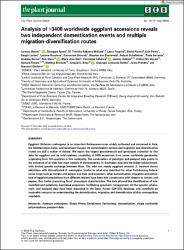Analysis of >3400 worldwide eggplant accessions reveals two independent domestication events and multiple migration-diversification routes

Göster/
Erişim
info:eu-repo/semantics/openAccessTarih
2023Yazar
Barchi, LorenzoAprea, Giuseppe
Rabanus-Wallace, M. Timothy
Toppino, Laura
Alonso, David
Portis, Ezio
Lanteri, Sergio
Gaccione, Luciana
Omondi, Emmanuel
van Zonneveld, Maarten
Schafleitner, Roland
Ferrante, Paola
Börner, Andreas
Stein, Nils
Díez, Maria José
Lefebvre, Veronique
Salinier, Jérémy
Boyacı, Hatice Filiz
Finkers, Richard
Brouwer, Matthijs
Bovy, Arnaud G.
Rotino, Giuseppe Leonardo
Prohens, Jaime
Giuliano, Giovanni
Üst veri
Tüm öğe kaydını gösterKünye
Barchi, L., Aprea, G., Rabanus-Wallace, M. T., Toppino, L., Alonso, D., Portis, E., Lanteri, S.,...& Bovy, A.G. (2023). Analysis of >3400 worldwide eggplant accessions reveals two independent domestication events and multiple migration-diversification routes. Plant Journal. https://doi.org/10.1111/tpj.16455Özet
Eggplant (Solanum melongena) is an important Solanaceous crop, widely cultivated and consumed in Asia, the Mediterranean basin, and Southeast Europe. Its domestication centers and migration and diversification routes are still a matter of debate. We report the largest georeferenced and genotyped collection to this date for eggplant and its wild relatives, consisting of 3499 accessions from seven worldwide genebanks, originating from 105 countries in five continents. The combination of genotypic and passport data points to the existence of at least two main centers of domestication, in Southeast Asia and the Indian subcontinent, with limited genetic exchange between them. The wild and weedy eggplant ancestor S. insanum shows admixture with domesticated S. melongena, similar to what was described for other fruit-bearing Solanaceous crops such as tomato and pepper and their wild ancestors. After domestication, migration and admixture of eggplant populations from different regions have been less conspicuous with respect to tomato and pepper, thus better preserving ‘local’ phenotypic characteristics. The data allowed the identification of misclassified and putatively duplicated accessions, facilitating genebank management. All the genetic, phenotypic, and passport data have been deposited in the Open Access G2P-SOL database, and constitute an invaluable resource for understanding the domestication, migration and diversification of this cosmopolitan vegetable

















